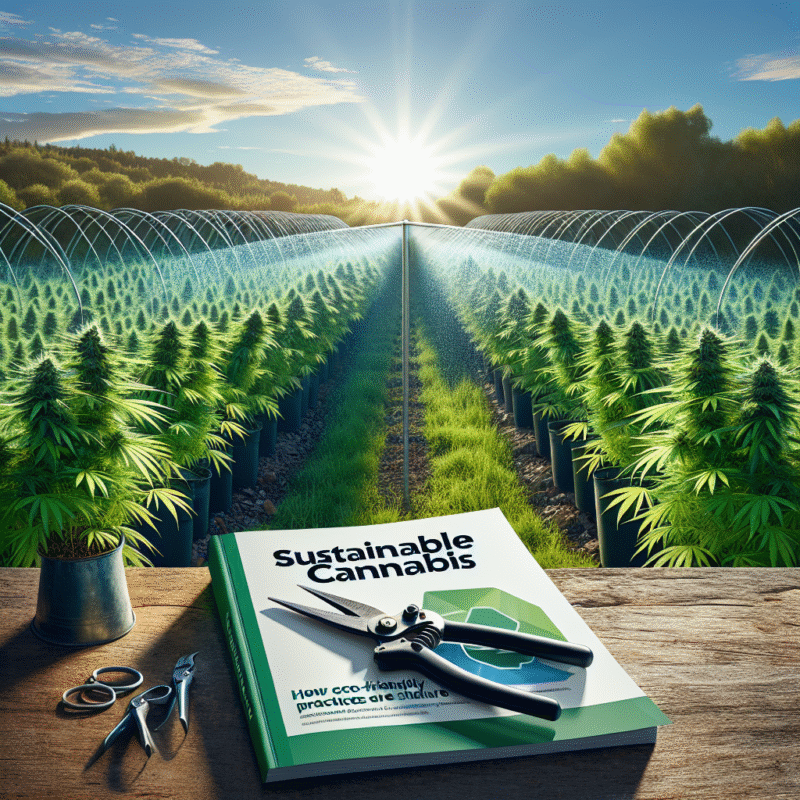Sustainable Cannabis: How Eco-Friendly Practices are Shaping the Future
As the cannabis industry continues to grow and evolve, so too does its responsibility towards the environment. With legalization spreading across various jurisdictions, the demand for cannabis products has skyrocketed. However, this boom has also raised concerns about its environmental footprint. Sustainable cannabis, characterized by eco-friendly practices in cultivation, processing, and packaging, is emerging as a vital facet of the industry’s future.
The Environmental Impact of Cannabis Cultivation
Traditional cannabis farming has often involved the use of harmful pesticides, fertilizers, and significant amounts of water and energy. High-intensity indoor grow operations, in particular, have raised eyebrows due to their substantial carbon footprints. These facilities can consume more energy than entire office buildings, primarily due to extensive lighting and climate control systems.
Moreover, outdoor cannabis cultivation can lead to deforestation, soil degradation, and water pollution if not managed responsibly. As consumer awareness grows, the industry is being pushed to adopt more sustainable practices to mitigate these adverse effects.
Eco-Friendly Cultivation Techniques
1. Organic Farming
Similar to organic agriculture in other sectors, organic cannabis farming eliminates the use of synthetic pesticides and fertilizers. Instead, these growers rely on natural alternatives, promoting biodiversity and soil health. Organic practices often lead to healthier plants and reduce the risk of contaminating local ecosystems.
2. Water Conservation
Water scarcity is a pressing global issue, and the cannabis industry is no exception. Innovative practices such as rainwater harvesting, drip irrigation, and hydroponics not only conserve water but also enhance the efficiency of nutrient uptake. By utilizing these methods, cultivators can significantly reduce water usage while maintaining healthy yields.
3. Regenerative Practices
Regenerative agriculture focuses on rebuilding soil health, enhancing biodiversity, and improving ecosystems. Techniques such as cover cropping, agroforestry, and composting enrich the soil and foster resilience against pests and diseases. Some cannabis farmers are implementing these practices to not only produce high-quality crops but also contribute positively to their local environments.
Sustainable Processing and Packaging
Once harvested, cannabis undergoes various processing stages, from drying and curing to extraction and manufacturing. These steps can also be resource-intensive.
1. Energy-Efficient Processing
Transitioning to renewable energy sources, such as solar or wind power, can greatly reduce the carbon footprint of cannabis processing facilities. Energy-efficient technologies, such as LED lighting and low-energy extraction methods, help lower energy consumption while maintaining product quality.
2. Eco-Friendly Packaging
Consumer goods increasingly meet demands for sustainable packaging. Cannabis products are no exception, with brands seeking biodegradable, recyclable, or reusable options. Innovations in packaging materials, such as compostable plastics made from plant sources, are helping to reduce waste and environmental impact.
The Role of Certifications and Standards
As sustainable practices become more mainstream, certifications such as USDA Organic or Certified Kind offer consumers assurance that products are produced responsibly. These certifications guide growers and manufacturers in adhering to eco-friendly practices, promoting sustainability across the supply chain.
Consumer Demand for Sustainability
Today’s consumers are increasingly conscious of their choices. Reports indicate that millennials and Gen Z shoppers show a strong preference for brands that prioritize sustainability. As a result, cannabis companies that embrace eco-friendly practices are more likely to appeal to this environmentally aware demographic. Whether through transparent sourcing, eco-conscious branding, or community involvement, sustainable practices resonate with consumers and can drive business growth.
Looking Ahead: The Future of Sustainable Cannabis
The future of the cannabis industry hinges on its ability to develop and implement sustainable practices. As regulations evolve and consumer expectations shift, eco-friendly cannabis will not merely be a niche market but a standard. Innovations in sustainable agriculture, processing technologies, and packaging solutions will continue to reshape the landscape.
Embracing sustainability is not just good for the planet; it also cultivates a positive image for brands and fosters customer loyalty. The cannabis industry is at a crossroads, and by prioritizing eco-friendly practices, it has the opportunity to lead by example in the broader conversation about sustainability.
Conclusion
Sustainable cannabis is no longer a buzzword; it’s a necessity. As the industry confronts its environmental impact, the adoption of eco-friendly practices will determine its future trajectory. By embracing organic cultivation, committing to energy-efficient processing, and investing in sustainable packaging, the cannabis sector can pave the way for a greener future, benefiting both the planet and its consumers. As awareness and demand for sustainable practices grow, the industry has the potential to become a model for environmental stewardship in all agricultural sectors.

